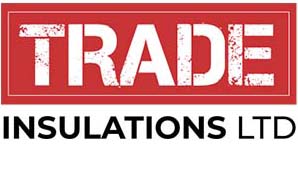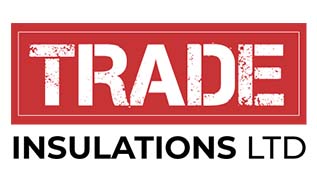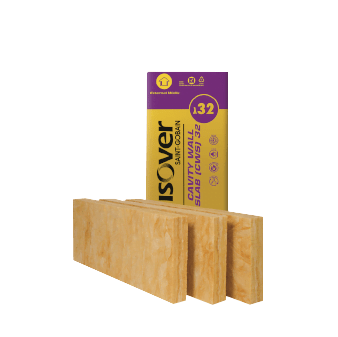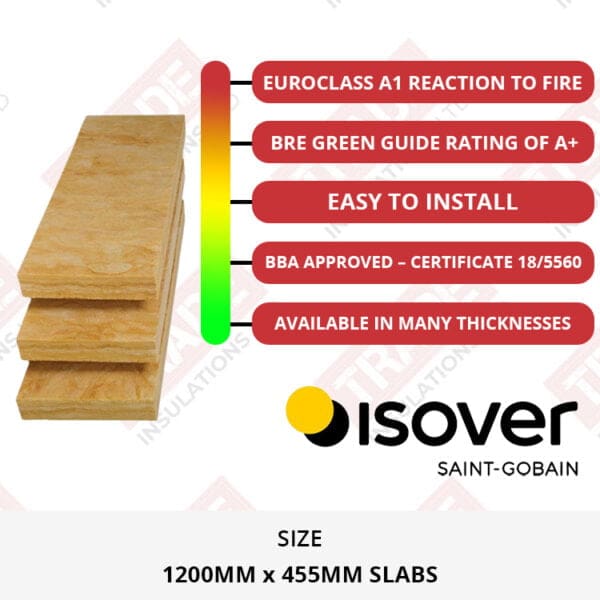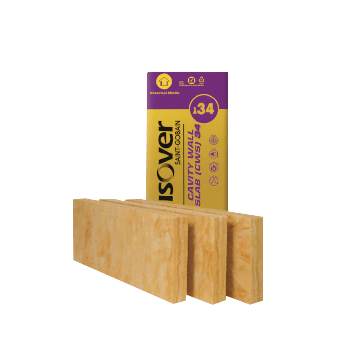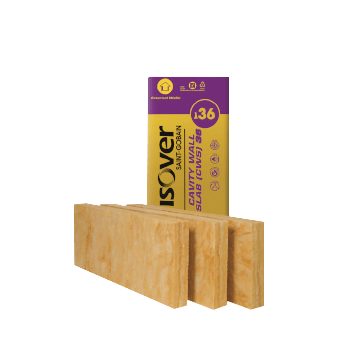Isover Cavity Wall Slabs
Isover Cavity Wall Slabs
Isover Cavity Wall Slabs are a high-performance insulation solution designed specifically for use in masonry cavity walls. These slabs are made from glass mineral wool, which is a lightweight and flexible material that offers excellent thermal and acoustic insulation properties.
Isover Cavity Wall Slabs are designed to provide optimal insulation in walls with a cavity. These slabs are manufactured to the highest quality standards and offer a range of benefits that make them an ideal choice for cavity wall insulation.
Showing all 13 results
100mm Isover Cavity Wall Slabs 32 (CWS 32) – 1200 x 455mm – 3.28m2 Pack
Original price was: £45.36.£35.87Current price is: £35.87.125mm Isover Cavity Wall Slabs 34 (CWS 34) – 1200 x 455mm – 65.6m2 pallet
Original price was: £904.03.£821.85Current price is: £821.85.150mm Isover Cavity Wall Slabs 34 (CWS 34) – 1200 x 455mm – 65.6m2 pallet
Original price was: £1,078.10.£980.10Current price is: £980.10.100mm Isover Cavity Wall Slabs 36 (CWS 36) – 1200 x 455mm – 6.55m2 pack
Original price was: £41.60.£37.82Current price is: £37.82.100mm Isover Cavity Wall Slabs 34 (CWS 34) – 1200 x 455mm – 87.4m2 pallet
Original price was: £967.64.£879.67Current price is: £879.67.75mm Isover Cavity Wall Slabs 36 (CWS 36) – 1200 x 455mm – 8.74m2 pack
Original price was: £42.10.£38.27Current price is: £38.27.150mm Isover Cavity Wall Slabs 36 (CWS 36) – 1200 x 455mm – 3.28m2 pack
Original price was: £31.18.£28.35Current price is: £28.35.125mm Isover Cavity Wall Slabs 36 (CWS 36) – 1200 x 455mm – 109.25m2 pallet
Original price was: £866.45.£787.68Current price is: £787.68.150mm Isover Cavity Wall Slabs 32 (CWS 32) – 1200 x 455mm – 2.18m2 pack
Original price was: £45.36.£36.62Current price is: £36.62.125mm Isover Cavity Wall Slabs 32 (CWS 32) – 1200 x 455mm – 40.95m2 pallet
Original price was: £679.40.£516.95Current price is: £516.95.50mm Isover Cavity Wall Slabs 36 (CWS 36) – 1200 x 455mm – 10.92m2 pack
Original price was: £35.08.£31.89Current price is: £31.89.75mm Isover Cavity Wall Slabs 32 (CWS 32) – 1200 x 455mm – 81.9m2 pallet
Original price was: £849.53.£701.58Current price is: £701.58.75mm Isover Cavity Wall Slabs 34 (CWS 34) – 1200 x 455mm – 109.2m2 pallet
Original price was: £904.03.£821.85Current price is: £821.85.The benefits of using Isover Cavity Wall Slabs
One of the key benefits of Isover Cavity Wall Slabs is their excellent thermal insulation properties. The glass mineral wool material used to make these slabs has a low thermal conductivity, which means it can effectively reduce heat loss through walls. This can help to reduce energy bills and improve the energy efficiency of homes and buildings.
Isover Cavity Wall Slabs are also excellent at reducing noise pollution. The glass mineral wool material absorbs sound waves and reduces the amount of noise that can pass through walls. This can help to improve the acoustic performance of homes and buildings, creating a more peaceful and comfortable living or working environment.
Another benefit of Isover Cavity Wall Slabs is their fire resistance. These slabs are made from non-combustible materials and can help to prevent the spread of fire in the event of a fire. This can help to improve the safety of homes and buildings and provide peace of mind to occupants.
How to install Isover Cavity Wall Slabs
Installing Isover Cavity Wall Slabs is a relatively simple process that can be completed by a professional installer or a DIY enthusiast. The first step in the installation process is to ensure that the wall cavity is clean and free from any debris or obstructions.
Once the wall cavity has been prepared, the Isover Cavity Wall Slabs can be installed by cutting them to size and shape using a sharp knife or saw. The slabs can then be pushed into the cavity and held in place using wire or plastic fixings.
It is important to ensure that the slabs are pushed firmly into the cavity and that they fit snugly against the wall surface. Any gaps or spaces between the slabs should be filled with additional insulation material to ensure optimal thermal and acoustic performance.
When installing Isover Cavity Wall Slabs, it is important to pay attention to any electrical cables or pipes that may be present in the wall cavity. These should be carefully positioned around the insulation to ensure that they are not damaged or covered by the insulation material.
Finally, it is important to ensure that the insulation is installed in a continuous layer without any gaps or spaces that could compromise the thermal or acoustic performance of the wall. By following these simple steps, it is possible to achieve optimal insulation performance and create a comfortable and energy-efficient living or working environment.
What Is The Difference Between Cavity Walls Slabs 32, 34 And 36?
The Cavity wall slabs differ in thicknesses available, and the thermal conductivity provided. Different slabs can be used depending on the thermal conductivity you require in your property and the thickness needed for your insulation needs. Each slab is named after the thermal conductivity provided for example, Cavity wall slab 32 provides a thermal conductivity of 0.032W/mK.
All Isover cavity wall slabs are easy to cut if necessary and can be simply cut using a sharp knife. A mat or protective layer should be applied to the floor before cutting so the floor does not get damaged when cutting the slab. A ruler or plank can be used as a tool to hold the insulation slabs in place and provide a guide whilst cutting.
Cavity wall insulation will save you money on your energy bills by preventing heat from escaping through the walls. It keeps your property cooler in the summer and warmer in the winter. A more temperature-controlled environment means more comfortable living and working conditions. It also means lower monthly energy bills and making your residential building more energy efficient. By reducing the heat escaping the property you are contributing towards climate change and the reduction of global warming.
When installing cavity wall insulation remember to take the building’s fixtures and fitting into consideration as it can increase or decrease the wall depth. This can affect factors such as the space in the room. Also take safety measures to ensure insulation is fitted correctly around electrical sockets, wires and ventilation spaces, or the correct procedures are put into place to remove these components. Always consult a building professional when insulating your walls to prevent the wrong insulation being installed and the possibility of damaging your property.
How to correctly store Isover Cavity Wall Slabs
Proper storage of Isover Cavity Wall Slabs is essential to ensure that they maintain their performance and quality over time. These insulation slabs should be stored in a dry and ventilated area that is protected from exposure to moisture, direct sunlight, and extreme temperatures.
When storing Isover Cavity Wall Slabs, it is important to keep them away from any sources of ignition or combustible materials to prevent the risk of fire. The insulation slabs should be stored on pallets or shelves to prevent them from coming into contact with the ground, which could cause damage to the insulation material.
It is also important to handle Isover Cavity Wall Slabs with care to prevent any damage to the insulation material. The slabs should be lifted and moved using appropriate lifting equipment, such as a forklift or crane, to prevent any bending or compression of the insulation material.
What are Isover Cavity Wall Slabs made of?
Isover Cavity Wall Slabs are made of glass mineral wool, a lightweight and highly effective insulation material that provides excellent thermal and acoustic performance.
Can Isover Cavity Wall Slabs be used in all types of buildings?
Isover Cavity Wall Slabs are suitable for use in a wide range of buildings, including residential, commercial, and industrial properties. They are particularly effective for improving the thermal performance of masonry cavity walls.
How are Isover Cavity Wall Slabs installed?
They can be installed by cutting them to size and shape using a sharp knife or saw, and pushing them into the cavity. They should be held in place using wire or plastic fixings and any gaps or spaces should be filled with additional insulation material.
What are the benefits of using Isover Cavity Wall Slabs?
They provide excellent thermal and acoustic performance, helping to reduce heat loss and noise transmission in buildings. They are also fire-resistant and can help to improve the energy efficiency of buildings, resulting in lower energy bills for homeowners and businesses.
